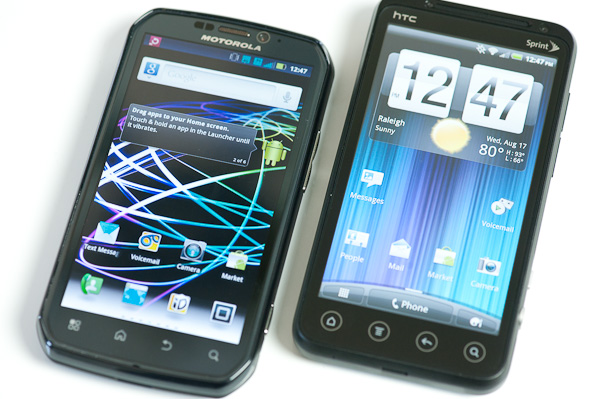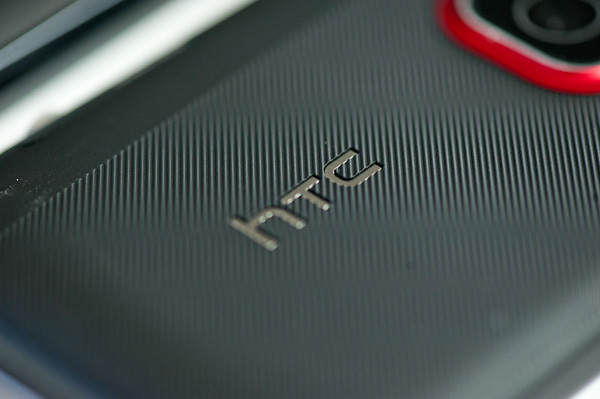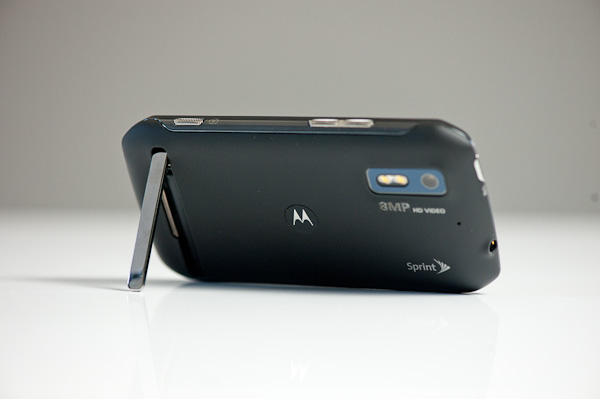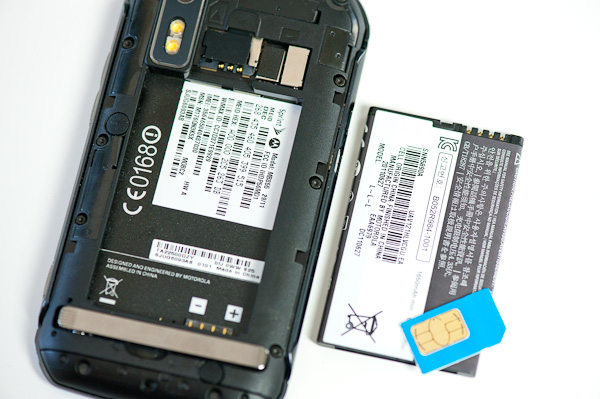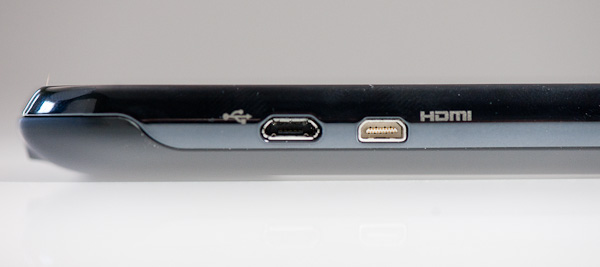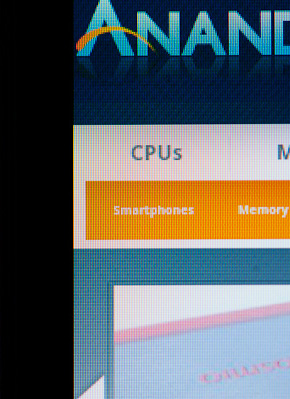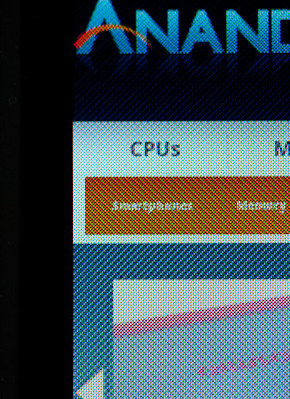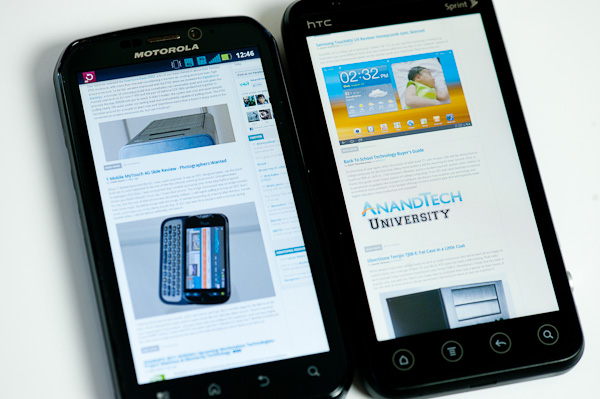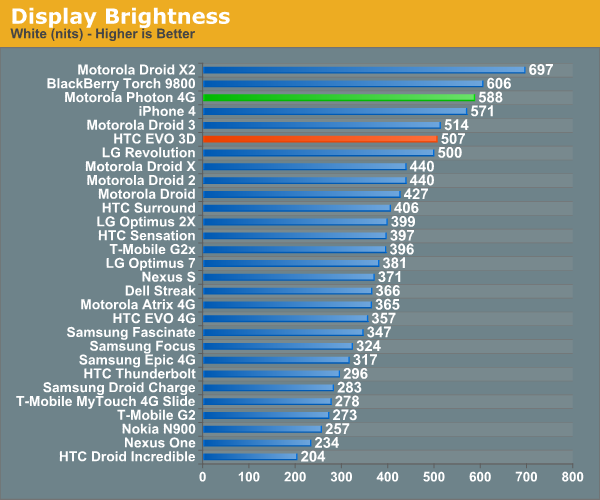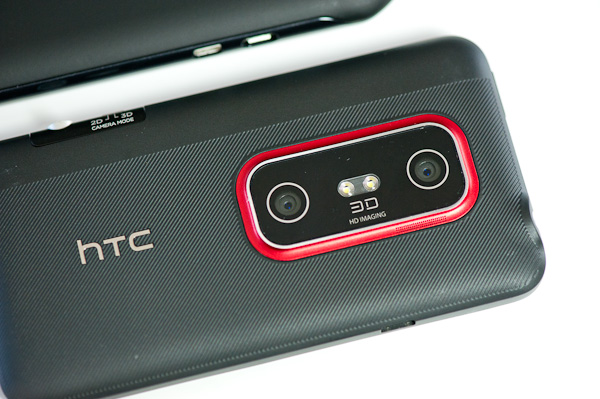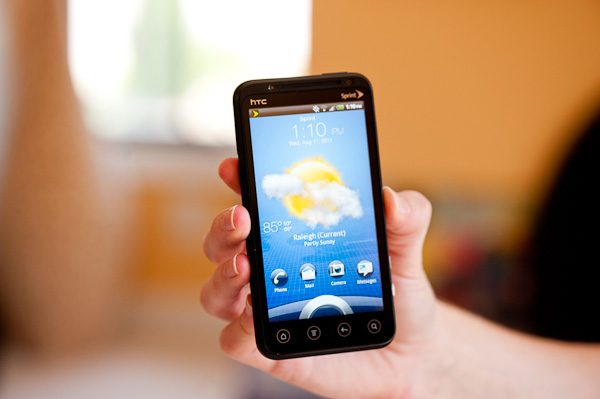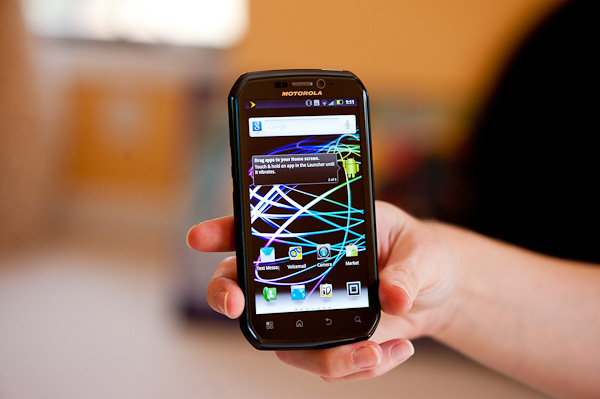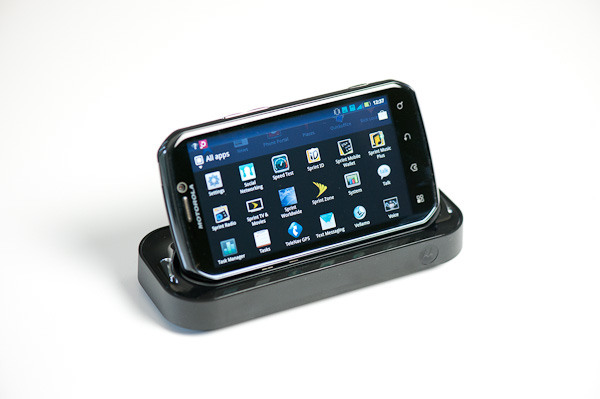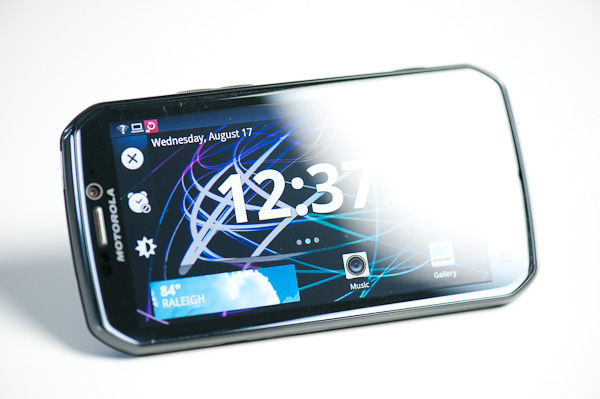
Original Link: https://www.anandtech.com/show/4643/htc-evo-3d-vs-motorola-photon-4g-best-sprint-phone
HTC EVO 3D vs. Motorola Photon 4G: Choosing the Best Sprint Phone
by Anand Lal Shimpi on August 17, 2011 11:11 PM ESTSprint customers almost always get the short end of the stick. In exchange for some of the more reasonable smartphone plans in the US, Sprint customers typically enjoy a mediocre selection of phones. Over the years there have been a few that have stood out. The Palm Pre and EVO 4G both come to mind. But generally speaking, all of the cool phones go elsewhere. In fact, the last Sprint phone we reviewed was the Samsung Epic 4G and that was almost a year ago. Of course more phones have debuted on Sprint since then, they just haven't been all that interesting.
Until now of course.
Today we have Sprint's two flagship Android smartphones: the HTC EVO 3D and the Motorola Photon 4G. Despite naming differences both support Sprint's 4G WiMAX network, have dual-core SoCs and boast 4.3-inch screens, but these two are far more different than you'd expect.
The EVO 3D uses a 1.2GHz Qualcomm Snapdragon S3 (MSM8660) and can capture/display 3D content. Meanwhile the Photon 4G is NVIDIA's debut phone on Sprint, featuring a 1GHz Tegra 2 and a high resolution 8MP rear camera sensor.
Before we get too far down the internal comparison, let's talk about the hardware itself first.
| Sprint EVO 3D vs. Photon 4G | ||||
| EVO 3D | Photon 4G | |||
| Height | 127 mm | 126.9 mm | ||
| Width | 66.0 mm | 66.9 mm | ||
| Depth | 11.9 mm | 12.2 mm | ||
| Weight | 170g | 158g | ||
| SoC | 1.2GHz dual-core Qualcomm Snapdragon S3 MSM8660 | 1GHz dual-core NVIDIA Tegra 2 | ||
| GPU | Qualcomm Adreno 220 | NVIDIA ULP GeForce | ||
| System Memory | 1GB | 1GB | ||
| NAND |
4GB NAND internal 8GB SanDisk class 4 microSD preinstalled |
16GB NAND internal |
||
| Display |
4.3" 3D qHD - 960 x 540 LCD |
4.3" qHD - 960 x 540 RBGW PenTile LCD |
||
| Display Output | HDMI via MHL | microHDMI | ||
| Front Camera | 1.3MP | 0.3MP | ||
| Rear Camera | 2 x 5MP 3D w/ Dual LED Flash | 8MP w/ Dual LED Flash | ||
| Battery | Removable 6.57 Whr | Removable 6.3 Whr | ||
| Shipping Android Version | 2.3.3 | 2.3.4 | ||
| Contract Price | $199 ($549 off-contract) | $199 ($549 off-contract) | ||
The physical comparison boils down to personal preference. The Photon has a lighter and more plasticky feel while the EVO 3D feels more dense and higher quality. Both are awkwardly large thanks to their 4.3" screen size, but the matte and textured finish of the EVO 3D actually does make it easier to hold than the Photon.
Where the Photon starts winning back points is with its kickstand. I've always been a fan of integrated kickstands and the Photon's is no exception. It's convenient for anyone that keeps their phone on a desk, uses it as an alarm clock or watches a lot of movies on it. Although I can't bring myself to spend two hours staring at a smartphone screen (even a large one), I know it's something that people do and the kickstand can be quite useful for those folks. Unfortunately you can't control the angle of the kickstand, so if you're super tall and seated in coach it may not be all that convenient.
Stylistically the EVO 3D takes a more conservative but well received approach, while the Photon tries something new with its long-octagon shape. There's nothing gained by Motorola chopping off the corners of the Photon, it's just different.
The Photon's atypical styling extends to the volume rocker as well. While the power/lock button is fairly standard, the volume rocker is textured with horizontal slits. Button presses are not firm but not mushy either.
The EVO's buttons by comparison are more traditional but extremely low profile. The obvious exception being the massive camera shutter release button, which feels good but not as great as you'd expect. It's also slightly disappointing that unlike on a WP7 device, hitting the camera button doesn't automatically bring the phone out of sleep and drop you into the camera app. If the EVO is unlocked and awake however, the button does just that.
To play up the 3D gimmick make it easier to switch between 2D and 3D shooting modes there's a physical toggle switch on the EVO 3D, next to the shutter release button. You only need the toggle for capture, when playing back content the display automatically switches between 2D and 3D modes.
Pulling off the back cover is far easier on the Photon. The EVO 3D makes you pull a little too much and some of the notches don't seem like they want to let go. Unlike some more recent HTC phones, the EVO 3D doesn't include any antennas in the rear cover - everything is baked into the body of the phone.
Both phones feature a removable battery. The EVO 3D has a 6.57 Wh unit while the Photon 4G's battery weighs in at 6.3 Wh. Behind the battery is a microSD card slot (with an 8GB card) on the EVO 3D. The Photon 4G on the other hand comes with no microSD card installed (but 16GB of NAND on-board) in addition to a SIM card. The Photon 4G includes a Qualcomm MDM6600 that gives it HSPA+/GSM support. The full list of supported networks and frequencies is below:
| Network Support | ||||||
| Total System Power | WiMAX | CDMA | WCDMA | GSM | ||
| HTC EVO 3D | 2.5 - 2.7GHz | 800/1900MHz | N/A | N/A | ||
| Motorola Photon 4G | 2.5GHz | 800/1900MHz | 850/1900/2100MHz | 850/900/1800/1900MHz | ||
If you're in need of a phone that can be used overseas, the Photon 4G is your only option of these two. The EVO 3D can only work on Sprint's CDMA and WiMAX networks.
The EVO 3D and Photon 4G both support HDMI out but through very different approaches. Motorola uses a standard micro HDMI connector, while HTC uses a MHL USB connector. When used with a standard USB cable the MHL USB connector acts like a normal micro USB port for charging and data transfer. If you've got an MHL to HDMI cable however you can get HDMI out of the phone. Unfortunately neither company ships their phone with the appropriate cable to get video output. With the right cable both phones support mirroring over HDMI.
The Display
In nearly every category the EVO 3D and Photon trade blows, each offering an advantage and a disadvantage depending on how you look at it. The display is the one area where I believe the EVO 3D is the undisputed champion. A quick macro shot comparing the display of the two phones reveals why:
Both have the same 960 x 540 display resolution and the same 4.3-inch screen size, but the Photon looks much grainier. You're looking at the difference between a RGBW PenTile panel and a standard LCD with full subpixel resolution. Motorola has gone the PenTile route in a few high profile phones as of late including the Atrix and Droid 3. The Photon simply adds to the list.
In normal use the Photon's PenTile panel doesn't pose much of a problem. If you're sold on the Photon everywhere else, don't let this be the deal breaker - you can get used to it. Scrolling will sometimes highlight the unique subpixel structure but mostly things just look grainy on the Photon. Small text, for example on a zoomed out web page, is the worst culprit - it just looks like there's no font smoothing enabled. It's livable but it's hardly desirable.
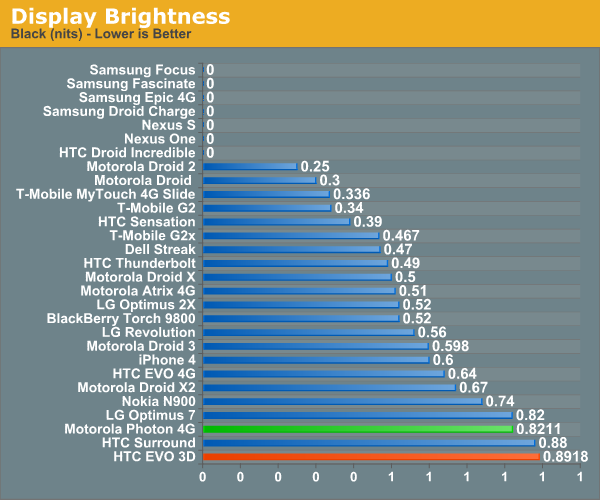
Both phones can get very bright, but their black levels are among the worst we've tested. While viewing angles are acceptable on these phones, they clearly don't use the highest quality panels available for this form factor. Contrast is reasonable but no where near as good as other phones we've reviewed.
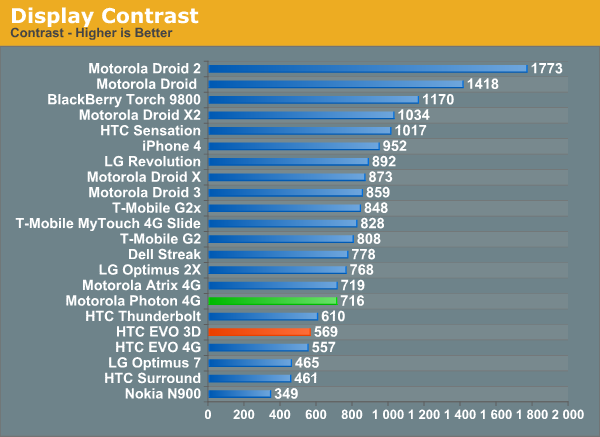
Although the phones have comparable brightness characteristics, they differ wildly in white levels. The Photon's white point is calibrated to around 8200K, making everything much bluer than normal - a trick we often see used in TVs and consumer displays.
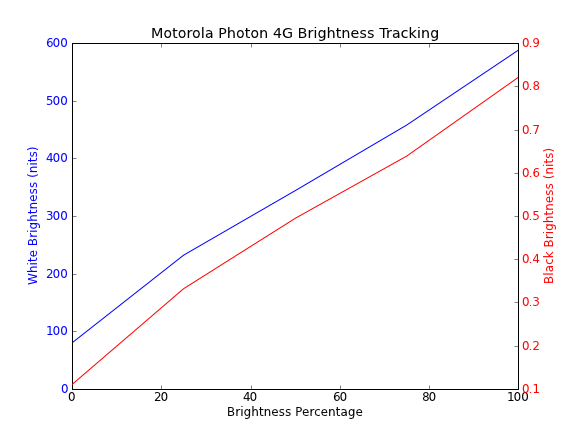
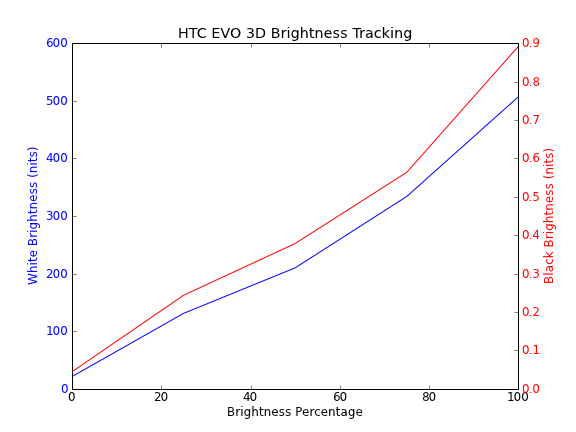
The EVO 3D by comparison delivers a better overall experience. Text looks sharper and the white point is at a more reasonable 6200K.
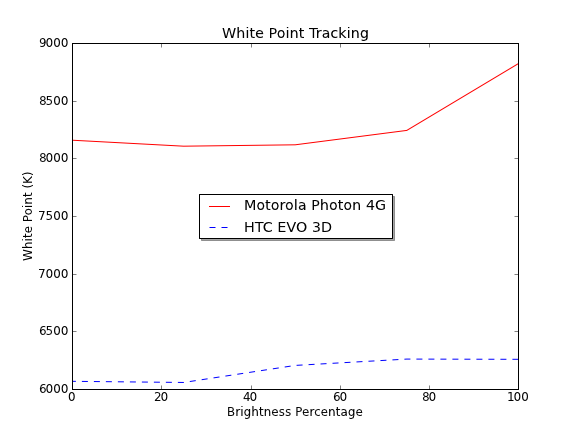
Whether or not the Photon's display is going to bother you depends mostly on how much text you read on your phone. Text messages are typically fine as the fonts themselves are large enough and they're against a white background. The issue is more pronounced, as I mentioned before, on web pages with small text. Once you zoom in the problem goes away, it's mostly an aesthetic issue when you first load up a web page since you're going to zoom in on any content you actually want to read. I'm not trying to excuse the use of an RGBW PenTile grid, I'm just trying to put its impact into perspective. It's not ideal but it's also not the end of the world.
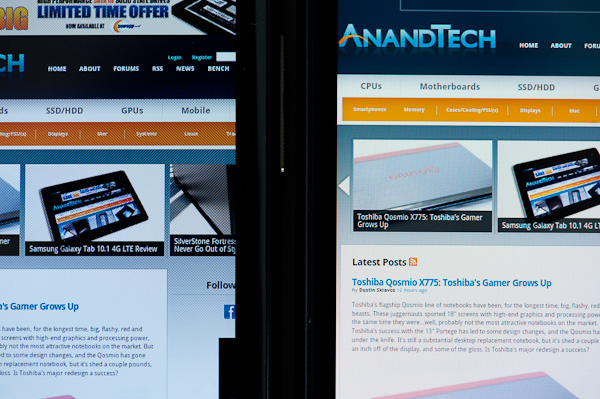
Photon (left) vs. EVO 3D (right)
Personally, I prefer the EVO 3D's display.
The Camera
On the upward curve of evolution, new ideas pop up all the time. As a result, reviewing two similarly priced smartphones rarely results in an overly boring comparison. These two contenders couldn't be any more different when it comes to their use of integrated cameras.
Both phones sport a front facing camera. You get a 1.3MP camera with the EVO 3D and a 0.3MP sensor in the Photon 4G.
The rear cameras in these two phones differ by more than just megapixel count. While the Photon sports a fairly standard 8MP sensor, the EVO 3D uses a pair of 5MP sensors to enable 3D capture. Supplementing the twin camera sensors is a S-LCD panel behind a parallax barrier, allowing for a glasses-free 3D effect.
A parallax barrier is a fixed element placed between the user and the LCD panel. The barrier forces your eyes to see different pixels. When the image displayed is a standard 2D image, everything looks normal. Each eye only gets to see half the display resolution but together you get the full picture.
If you use the half of the pixels shown to the user's left eye to display one image, and the other half to display another you can create the illusion of depth. This works along the same principle of 3D glasses where each eye is shown a different image, but instead of relying on headgear to show your eyes different images you rely on the parallax barrier.
Unlike 3D glasses however, a parallax barrier doesn't move with your head - it moves with the device. In other words, the 3D effect will only be visible at a very specific distance between the screen and your eyes. For 3D images, the total resolution is half the screen resolution since each eye only sees part of the picture.
While I'm not a fan of 3D displays in general, there's a compelling argument you can make for having 3D in a phone. Being able to both capture and display 3D content on a single device that you can easily show others is a lot easier of a sell than forcing people to wear glasses or run out and buy a special display. I often share photos with others on my phone and if the 3D effect was compelling enough, I could absolutely see myself doing the same with a 3D phone.
How does the EVO 3D fare? Surprisingly well once you nail down the right viewing distance. If you hold the phone too close to your face you get an effect that resembles a cheese holographic sticker. I started by keeping the phone as far away from me as possible and brought it closer until the image clicked.
The parallax barrier still relies on tricking your eyes into seeing depth, and as a result there is eye strain. When viewing still images it's not too big a deal since you don't have to stare at a single image for all that long. Watching videos is more painful. In either case I noticed the eye strain and it didn't feel good.
Just like 2D images, capturing 3D stills works best when you've got a steady hand and a lot of light. Given the right conditions, the effect is impressive (you'll need a 3D display and/or glasses to view these).
When you take a 3D photo you actually store the data for three images: a full resolution image, the data for the left eye and the data for the right eye. Images shot in 3D are stored as .MPO files. When you share a 3D image you have the choice of sending/uploading a .MPO file or a 2D JPEG. You can't zoom into a 3D image, doing so immediately triggers a switch to the 2D version.
Does the 3D camera give the EVO an edge over the Photon? I don't believe so, but I won't complain that the feature is there.
How do the two cameras stack up in 2D mode? It's pretty simple really. The Photon produces sharper images, while the EVO delivers more saturated/vibrant images. The Photon is probably closer to reality while the EVO's output is likely more appealing to the general consumer.

Motorola Photon 4G, Rear Camera Sample
At full resolution you notice the sharpness advantage of the Photon. Outdoors the Photon tends to mute bright days, while the EVO 3D blows out most highlights. Indoors the Photon does well, but its auto white balance seems off. The perfect camera would be somewhere in between the two in my opinion.

HTC EVO 3D, Rear Camera Sample
As far as camera apps go, I prefer HTC's. You get more options such as configurable review duration as well as a self timer. Both apps take a similar amount of time to launch, although HTC's is much quicker to switch between still and video modes. The EVO 3D's app also supports tap to focus whereas you have to drag the focus box around on the Photon.
Overall the Photon produces better images while the EVO 3D has a better camera app and produces more punchy (although oversaturated) images. If you just share photos on Facebook or keep them on your phone, the EVO 3D probably has the better camera. If you do anything beyond that the Photon takes the win. The EVO's 3D camera system is neat, but not enough to make up for its shortcomings in the sharpness department.
It makes sense when you think about it. Both phones have to sell for the same price, yet the EVO 3D's bill of materials calls for two rear camera sensors. You get two lower quality sensors as a result.
The Photon's advantage translates into videos as well, although in motion it's not as pronounced:
WiMAX Performance
When I reviewed the original Sprint EVO 4G I came away unimpressed with the carrier's WiMAX deployment in Raleigh, NC. Speeds were inconsistent at best and peak performance wasn't that much better than what I could get on AT&T's HSPA network. A year later, consistency is still an issue. Speeds vary wildly from only a couple hundred Kbps all the way up to several Mbps, even while remaining stationary!
Just yesterday I encountered a several hour period of time (across multiple towers) where I couldn't get more than 200Kbps down on either device. These complaints may be limited to the Raleigh, NC area but it's still something worth investigating ahead of any purchase.
When the network is behaving properly however, WiMAX is worlds better than Sprint's EVDO. Around here I max out at 800Kbps on EVDO and average south of 500Kbps. WiMAX at least gets me north of 1Mbps and sometimes a lot higher.
The EVO 3D and Photon 4G vary drastically when it comes to performance on WiMAX. The EVO 3D uses a Sequans SQN1210 WiMAX solution while the Photon 4G uses a chip from Beceem (now Broadcom). In areas with good signal the EVO 3D generally delivers higher performance. I ran nearly 50 speed tests on both phones at the exact same time at the exact same location (even varying which hand I held each device in). The results are below:
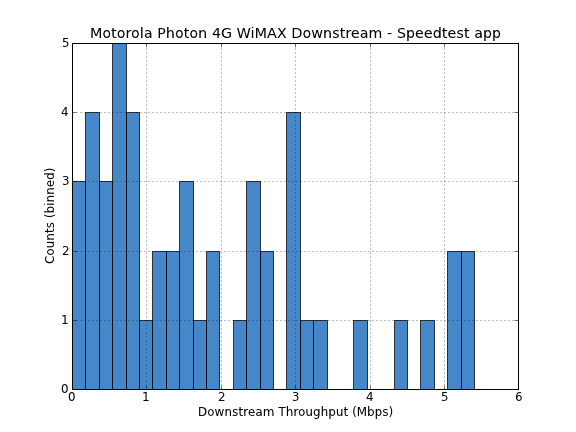
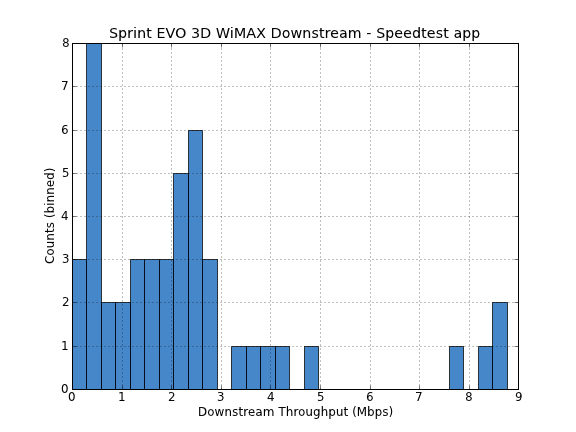
Downstream there's a pretty big difference between the EVO and Photon. While the Photon 4G maxed out at around 5Mbps, the EVO 3D could hit 9Mbps on WiMAX - the fastest I've ever seen on a WiMAX device in Raleigh. Admittedly the 8 - 9Mbps numbers were rare, but the EVO did consistently better than the Photon when it had good signal strength.
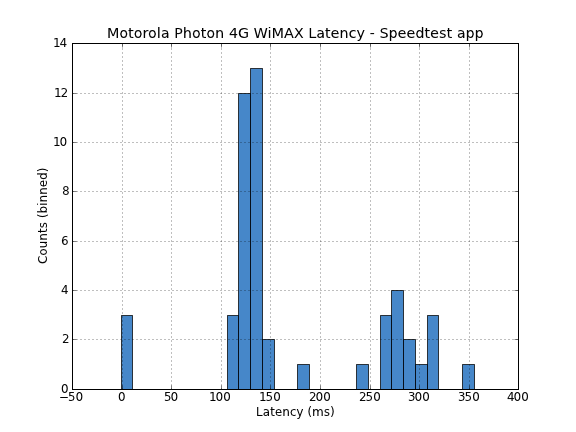
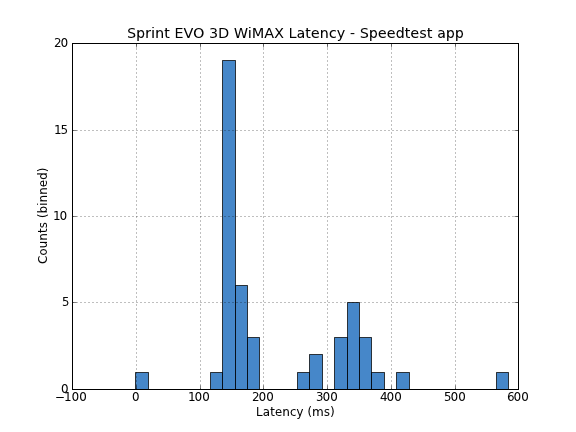
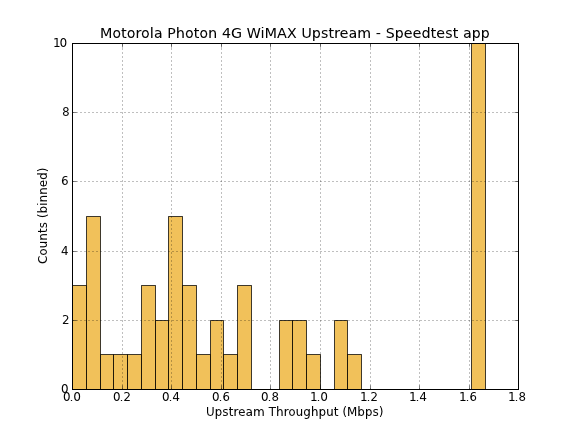
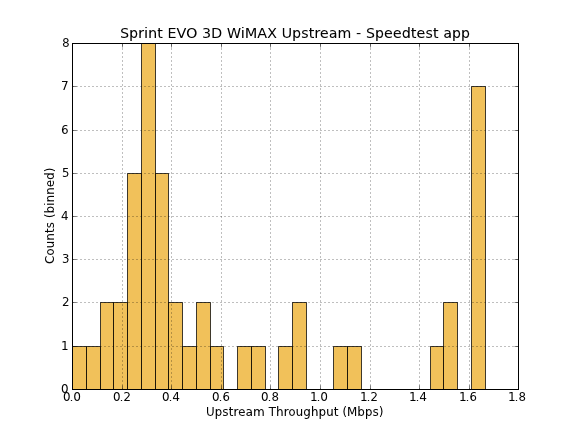
Unfortunately the EVO 3D has a difficult time holding on to a weak WiMAX signal. I'm around 1.5 miles away from the nearest WiMAX tower but only the Photon can consistently hold onto its signal from here. Even driving over to my parents' house which is nearly at the half-way point between me and the tower isn't enough for the EVO 3D to stay connected consistently. There are a lot of trees in Raleigh and quite a few of them are between both houses and the tower. WiMAX has notoriously bad signal propagation characteristics as a result of its very high frequency (2.5GHz). All of that considered, the Photon still holds onto a WiMAX signal better than the EVO 3D - at least in my experience.
I don't have an activated EVO 4G on hand, but if things didn't get worse in the past year for WiMAX reception at my house I'd go as far as to say that the EVO 3D isn't as good as its predecessor when it comes to staying on WiMAX at the fringe.
Because of the EVO 3D's inability to remain on WiMAX consistently at my house I wasn't able to complete a single run of our WiMAX battery life test. The Photon completed the test without issue, but the EVO 4G would consistently drop off WiMAX and fall back to 3G. I briefly considered hiding the EVO 4G next to the WiMAX tower for the duration of the test but figured it'd be better not to risk the review sample getting stolen.
Again we find ourselves in a difficult position with these two phones. If you're in an area with great WiMAX coverage, the EVO 3D is the better performer. If you don't have great WiMAX reception where you plan on using your phone the most, the Photon 4G is clearly better.
Software
Both the Photon 4G and EVO 3D run Gingerbread, although the Photon sports a slightly newer version (2.3.4 vs 2.3.3). The newer point release on Photon simply implements bug fixes, but don't take that to mean that the Photon should be a more stable phone. In my experience with the two, the Photon was more likely to crash although neither phone appeared to be particularly unstable.
The EVO 3D ships with HTC's Sense 3.0 UI and associated apps. We've covered Sense 3.0 extensively in previous articles, but our general feeling is that it's mostly a useful addition to Android. While I wish all phones would deliver a stock Android experience and let you simply add functionality on your own, Sense 3.0 isn't a pain to use.
Motorola's skin on the Photon isn't nearly as polished looking or functional as Sense 3.0 but it's not obnoxious either. Both UIs have good keyboards. Motorola's browser executes javascript faster than HTC's, while HTC's allows for smoother scrolling. Again with the tradeoffs.
Overall my preference here is the EVO 3D but I could live with either.
The Photon does have one feature the EVO 3D can't match: Motorola's Webtop App. Motorola first introduced us to its Webtop app on the Atrix, but its implementation on the Photon remains mostly unchanged. With the Photon 4G docked or connected to an external display via HDMI you have the option of firing up the Webtop app - a self contained Linux environment with a full version of Firefox 4.0.1. You can either use the Photon itself as a keyboard/mouse or you can tether input devices via Bluetooth. If you've got the multimedia dock there are three USB ports you can use instead. The idea is that can leave your netbook at home and use your phone, dock and portable keyboard as your PC on the go.
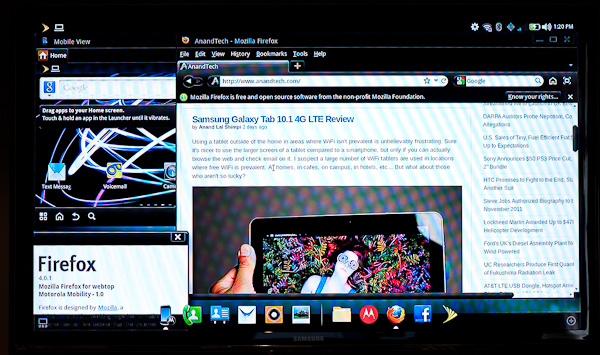
Motorola's Webtop App via HDMI on a TV
The Webtop experience is neat but only for light usage. We're still far from being able to duplicate a PC browsing experience on a smartphone but it's good to see manufacturers toying with the idea. In a couple of years it may just be reality.
Performance
The Photon 4G uses NVIDIA's first mobile SoC with widespread acceptance: the Tegra 2. Although it only started appearing in Android phones and tablets this year, the design itself dates back to a year prior to its introduction. Despite its age, Tegra 2 does very well against the current competition. Its architecture is pretty simple to explain. You get a pair of ARM Cortex A9 cores running at up to 1GHz with a 1MB L2 cache shared between them. Although each core has a pipelined FPU, neither has ARM's MPE - a SIMD engine needed to run NEON code. NVIDIA built in a low power GeForce GPU into the Tegra 2 and while we've had complaints about it on tablets, at smartphone resolutions the ultra mobile GeForce seems to do reasonably well. Feeding the Tegra 2 is a single channel 32-bit LPDDR2 memory interface.
The EVO 3D on the other hand uses Qualcomm's latest SoC: the MSM8660, which falls under the new S3 brand. Here we also have two cores, although each one is a mostly in-order design running at 1.2GHz. NVIDIA originally told me that the move to out-of-order yielded a 20% increase in IPC at the same clock speed, so Qualcomm's 20% clock speed advantage should help level the playing field between the two on a CPU level. Qualcomm includes both a fully pipelined FPU as well as a NEON unit in each core, giving it an advantage in applications that are accelerated with NEON code. Admittedly to date there isn't a ton available to show where NEON can be advantageous so I don't know how much of an advantage this really ends up being. The two cores share a 512KB L2 cache but have a dual-channel memory interface.
Qualcomm is particularly proud of its ability to run each core at a frequency independent of the other. I haven't been able to demonstrate a tangible advantage to this feature yet and Qualcomm hasn't announced whether it will be present in future SoCs as well so the verdict is still out on this one.
The Adreno 220 is Qualcomm's highest end GPU (for now). Unfortunately we can't talk about its architecture as Qualcomm isn't publicly disclosing much but it is the fastest in the shipping Adreno lineup.
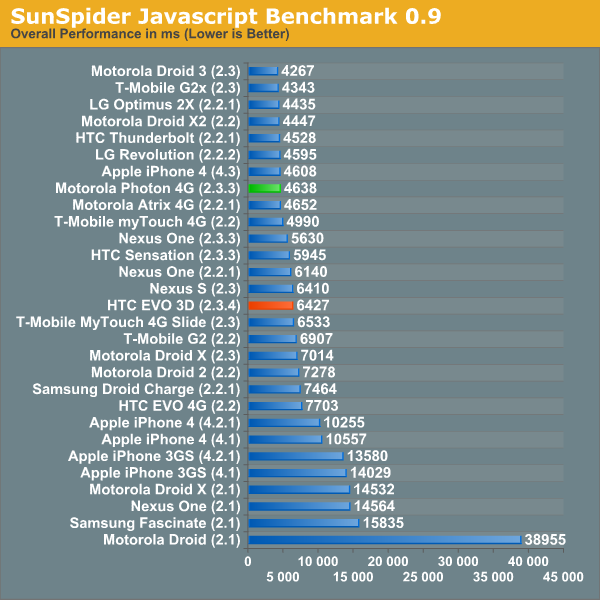
I already alluded to differences in the web browsers of these two phones resulting in varying javascript performance. HTC's browsers have traditionally not performed too well in our javascript tests and unfortunately the EVO 3D is no exception. In our tests it performed a bit worse than its counterpart, the Sensation. In any case, the Photon 4G has two advantages here: the out-of-order A9 architecture as well as a browser with a faster js engine. The comparison here isn't as cut and dry though. Although the EVO 3D's browser has a slower javascript engine, it does scroll smoother than the Photon's browser. The smoother scrolling on the EVO 3D is correctly encapsulated in the relevant scrolling tests in Qualcomm's Vellamo benchmark:
| Qualcomm Vellamo Benchmark - Scrolling Performance Tests | |||||
| Ocean Flinger | Image Flinger | Text Flinger | |||
| HTC EVO 3D | 68.98 | 26.03 | 41.79 | ||
| Motorola Photon 4G | 62.07 | 17.64 | 35.21 | ||
Despite Vellamo being a Qualcomm developed benchmark, the scores in these three tests do echo what I noticed after using the two phones. The EVO 3D's browser has better scrolling performance than the Photon. Neither is perfectly smooth, but the HTC browser is noticeably better than Motorola's.
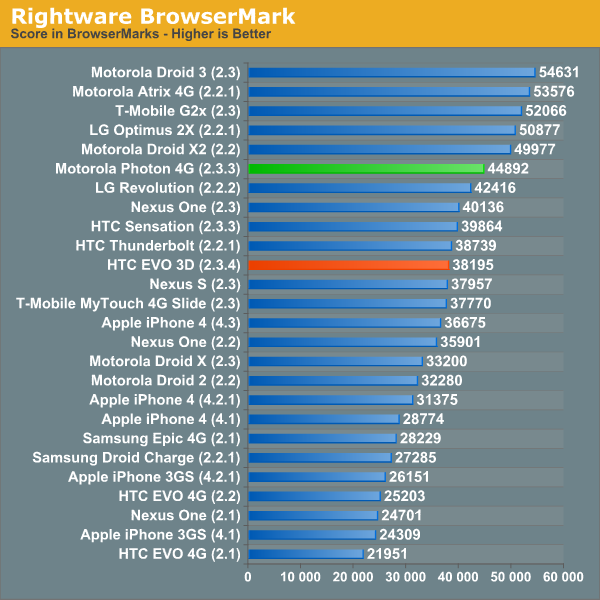
BrowserMark echoes the javascript rendering advantage of the Photon.
Flash performance complicates things. The Photon has consistently better Flash performance regardless of benchmark. GUIMark 2's Vector Charting Test shows the biggest issue with the EVO 3D:
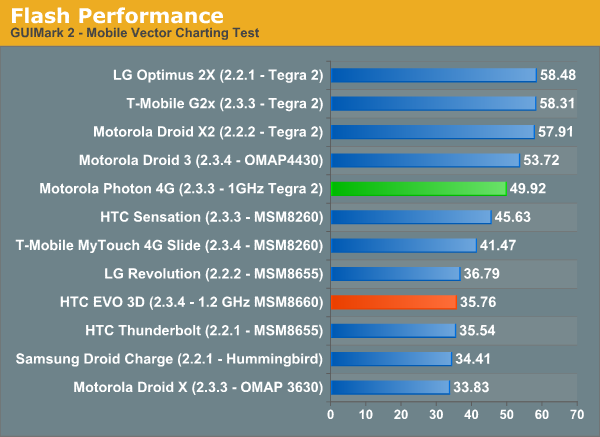
Although the EVO 3D reaches frame rates that are similar to the Photon, lots of stuttering pulls down the average frame rate to what you see above. NVIDIA's Tegra 2 is a clear winner when it comes to Flash performance. Only the OMAP 4 comes close. I'm not entirely sure why the Sensation does so well here, but there's a definite grouping of the Qualcomm based parts.
| GUIMark 3 Performance | ||||||||
| Bitmap - HTML5 Cached | Bitmap - Flash | Vector Test - HTML5 | Vector Test - Flash | Compute - HTML5 | Compute - Flash | |||
| HTC EVO 3D | 51.1 fps | 47.9 fps | 12.4 fps | 27.7 fps | 5.6 fps | 23.3 fps | ||
| Motorola Photon 4G | 37.3 fps | 45.4 fps | 12.1 fps | 35.4 fps | 6.8 fps | 31.3 fps | ||
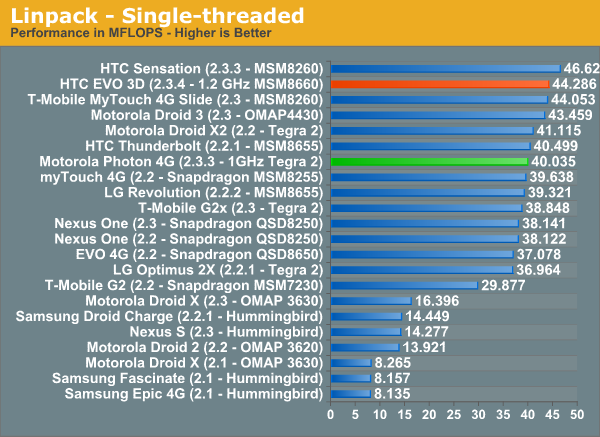
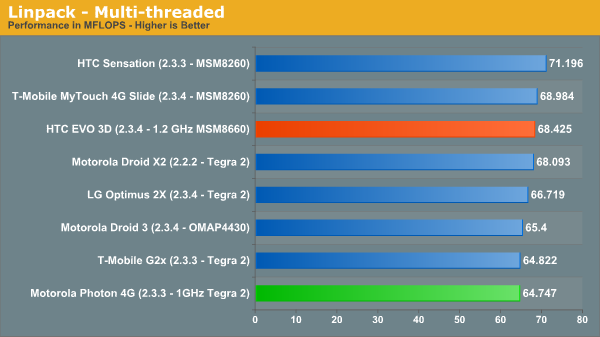
Linpack isn't all that useful of a benchmark under Android, but it does give us an idea of floating point performance of these two platforms. In both cases HTC pulls ahead, likely due to its clock speed advantage.
The GeForce in NVIDIA's Tegra 2 is growing old compared to the latest and greatest from Qualcomm and Imagination. Despite its age however, the Tegra 2 still holds its own pretty well among other qHD competitors. The Adreno 220 and SGX 540 are still faster in our tests though:
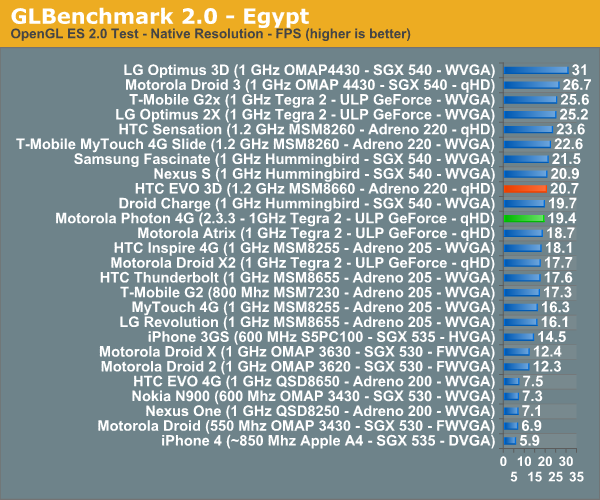
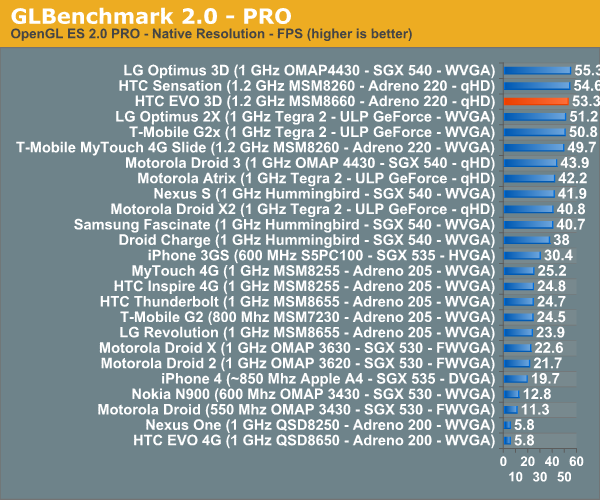
The huge advantage really comes from Basemark ES2 which seems to prefer deferred rendering architectures like the Adreno 220 and SGX 540 to NVIDIA's immediate mode renderer:
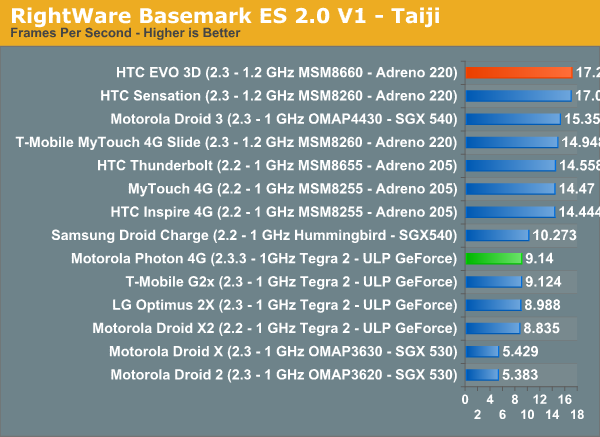
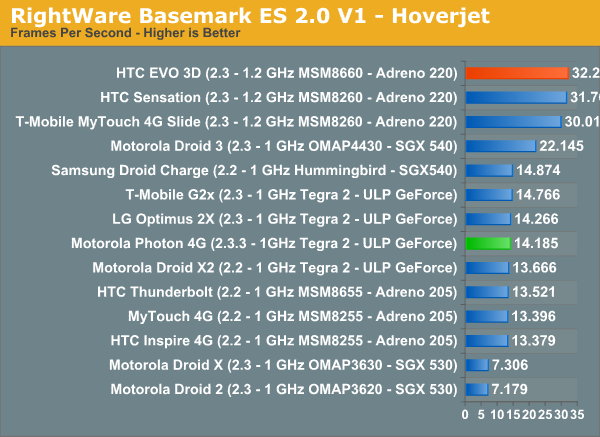
It's difficult to call an overall performance winner here. As we've seen throughout the review, both NVIDIA and Qualcomm trade blows here. The Tegra 2 based Photon 4G has the advantage in Flash and javascript performance while the Snapdragon based HTC delivers smoother browser scrolling and better 3D performance.
Battery Life
Both the Photon and EVO 3D have ginormous batteries. The Photon has the lower power display (a major benefit of PenTile), at least contributing to its advantage in the WiFi battery life test.
The Photon only fell behind the EVO 3D in our 3G battery life test. In fact, battery life was better on WiMAX, leading me to believe that the Photon's EVDO stack may not be all that power optimized. If you're on WiFi or using the device to make calls, the Photon will last longer on a single charge. Although the EVO 3D couldn't complete our battery life test while on WiMAX, I'd expect the two phones to at least be competitive there.
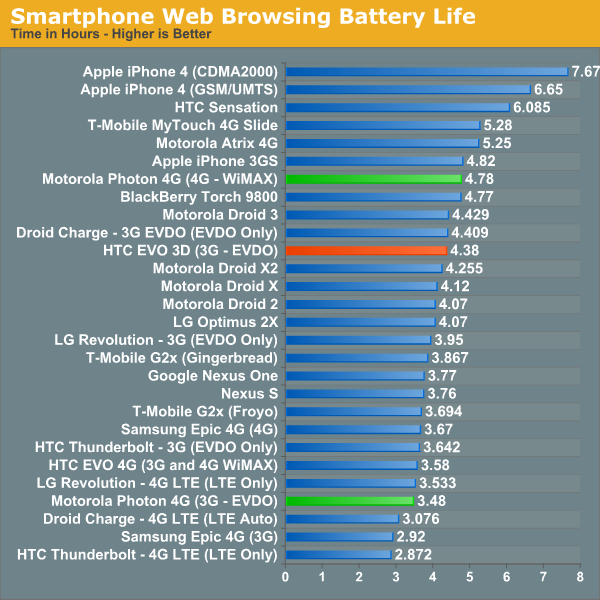
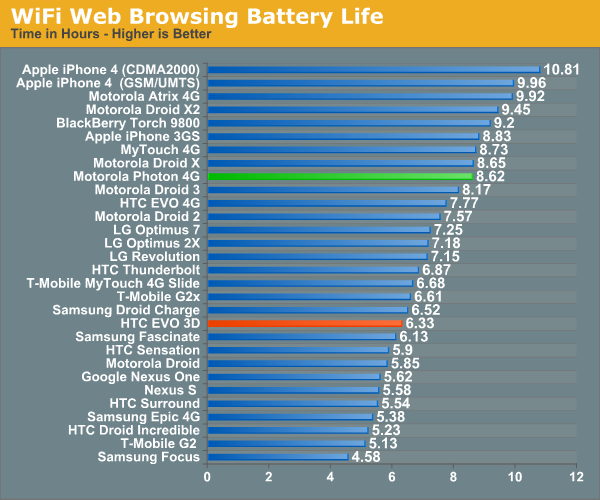
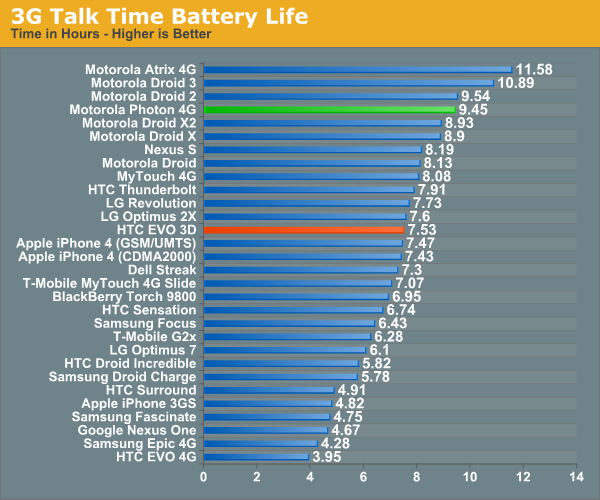
Final Words
I never thought I'd be so torn between two phones on Sprint's network before. The HTC EVO 3D and the Motorola Photon 4G truly have complementary strengths and weaknesses. The EVO 3D has a better display, while the Photon 4G has a better camera. The EVO delivers better WiMAX performance in areas with good signal strength, while the Photon is better in areas with poor reception. The EVO's browser scrolls smoother but renders slower. The Photon has better Flash performance, while the EVO has better 3D performance. The Photon does better on battery while the EVO has a better software layer on top of Android. To make matters worse, there are no good candidates from a third party. If you want the fastest there is on Sprint, these are your only two options.
How do you choose? I think it ultimately boils down to WiMAX reception. If it were me, I'd go for the Photon. Based on where I live I'm at the edge of WiMAX coverage. The EVO 3D can't hold onto a WiMAX signal reliably at my house so I'm constantly falling back to EVDO, while the Photon can hang on pretty well. If you live in an area with great WiMAX reception or find yourself on WiFi most of the time then the EVO starts to look a lot more appealing. If wireless reception is out of the equation then the EVO 3D's only major knock is its poor 2D camera quality, which is still good enough for sharing on the web.
So there you have it. If WiMAX reception matters, go for the Photon, otherwise grab the EVO 3D.

